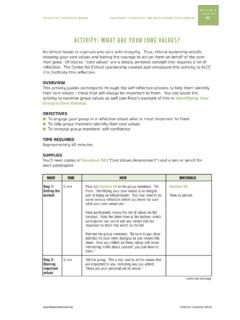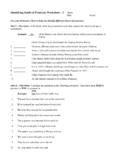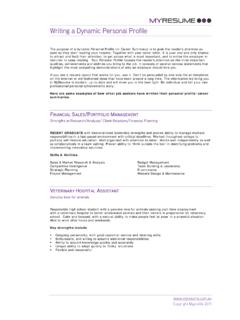Transcription of Training needs assessment - AMDIN
1 Training Manual Module 2: Training needs assessment Module 2 Training needs assessment 2007 South African Management Development Institute (SAMDI) 1 AMDIN public sector capacity development: Training of trainers programme Where are you in the process? MODULE 1: The context of Education, Training and Development Practices MODULE 2: Training needs assessment MODULE 3: Planning and Design of Outcomes-based Learning MODULE 4: Facilitating and assessing learning MODULE 5: Methods, media and technology in facilitating learning MODULE 6: Management and Evaluation of ETD practices MODULE 7: Continuous occupational expertise development 2 2007 South African Management Development Institute (SAMDI) Training Manual Module 2: Training needs assessment Module 2: Contents Learning 5 Aim of the 6 Introduction to Training needs 7 Activity.
2 What is Training needs assessment ?.. 8 Defining Training needs 9 Activity : Doing a Training needs 10 What kinds of needs are there?.. 12 What perceptions do people have of these needs ?.. 12 Personal development 14 Doing needs 15 Some guidelines on doing needs 15 needs assessment 17 Levels of Training needs 20 Sectoral level needs 20 Organisational level needs 20 Task 21 Personal 21 Doing a task 22 Activity : Task analysis: 23 The use of the term 'competency' in task 25 A Training and development needs assessment 27 Plan to 28 Training and development 29 Activity.
3 Establish Training and development 30 Develop competency 31 Activity : Develop a competency 33 2007 South African Management Development Institute (SAMDI) 3 AMDIN public sector capacity development: Training of trainers programme Data gathering methods and 34 Using questionnaires to collect data about Training 34 Qustionnaire 35 Questionnaire Activity : Develop a needs assessment 38 Develop Training needs assessment 39 Human Resource Development department and 40 Training 40 Human Resources, Training and development committee 40 41 Data analysis and plan 41 Evaluation and 46 Training needs assessment information 47 Activity : Review of Module 48 Checklist for 50 Activity : Group discussion on applying your 49 Evaluation of Module 51 2007 South African Management Development Institute (SAMDI) Training Manual Module 2.
4 Training needs assessment Learning outcomes After completing this module, you should be able to: Explain the concept of Training needs Describe different types and levels of needs Explain the importance of identifying the necessary job skills through a task analysis Be able to construct a list of relevant job competencies (a competency chart) from task analysis data Decide on the use of particular methods to collect data on Training needs Prepare a simple Training needs assessment questionnaire Interpret the information using appropriate methods of analysis Report on the Training needs assessment . 2007 South African Management Development Institute (SAMDI) 5 AMDIN public sector capacity development: Training of trainers programme Aim of the Module The aim of Module 2 is to introduce you to the first stage of the Training cycle, namely Training needs assessment .
5 Identifying the Training needs is the necessary start for any programme or course planning. This module will take you through all the steps in assessing Training needs . 6 2007 South African Management Development Institute (SAMDI) Training Manual Module 2: Training needs assessment Introduction to Training needs assessment Before Training design issues are considered, a careful needs analysis is required to develop a systematic understanding of where Training is needed, what needs to be taught or trained, and who will be trained. Unless such a needs assessment has been adequately performed it may be difficult to rationally justify providing a needs assessment should enable an explanation to be given on why the Training activities should be done, and also show that Training is, in fact, the best solution for the performance problem or development need.
6 A needs assessment can be an important tool for any trainer or organisation planning a programme or course. Accurate needs assessment can help develop a programme or course based on the real needs of the people that it is serving. As time is often limited in Training programmes, courses which takes learners needs into account can ensure that what is most useful for learners is covered. Figure : General system model for people development (based on Swanepoel, Erasmus, van Dyk and Schenk, 2003, p. 454) Phase 1 needs assessment Phase 2 Training Phase 3 Evaluation Assesss Training and development needs Evaluation levels Organisational and job/task analysis Learning principles and Training and development methods Evaluation designs Individual analysis Conduct Training Value of Training Derive Training and developmental outcomes to be achieved Feedback 2007 South African Management Development Institute (SAMDI) 7 AMDIN public sector capacity development: Training of trainers programme Activity : What is Training needs assessment ?
7 Every job, whether complicated, such as budgeting for a major programme, or just an ordinary task, such as filing some papers in a filing cabinet, requires you to have knowledge and skills appropriate to the task. If you are not skilled (or skilled enough) to do a job, it becomes difficult to do it (or may even be impossible). Once you realise that you cannot do a job properly, you are halfway to identifying your Training needs . Based on this introductory explanation, what would you say a Training needs assessment is (' assessment ' meaning to judge the quality or worth of something, usually by comparing it against some measure or standard). Training needs assessment is.
8 8 2007 South African Management Development Institute (SAMDI) Training Manual Module 2: Training needs assessment Have you included in your thoughts on this issue elements like: measuring the elements of success in a job (how well a job is to be done)? mistakes made on the job, that indicate that the standard is not met? feelings of incompetence in doing a job? deficiencies (or gaps) in an employee s skills and knowledge base? Include these elements in your thinking and see what type of definition for Training needs assessment you can come up with. Defining Training needs assessment A Training needs assessment can be defined as determining the gap between what an employee must be able to do and what he or she can or is currently doing.
9 A Training needs assessment (also called a Training needs analysis ) therefore identifies the gap between what the job expects an employee to do, on the one hand, and what the employee is actually doing, on the other. A Training needs analysis discovers whether there is a discrepancy or conflict between what an employee ought to be doing and that which he or she can do. How the job ought to be properly done The gap How the employee is doing or can do the job now Ought to be properly done indicates what someone is expected to do (the standard or level of performance). Is doing/can do is the way in which someone is doing some job now (currently).
10 If the way in which I am filing or budgetting is not on the level that it is supposed to be, then a gap is formed. The gap is the difference between what I am doing now, while working, and what is expected of me, that is, the way in which a good public servant ought to be working. Any job requires a person to meet certain standards. Standards are levels of expertise or skills one has to comply with to do a job properly. Whenever one does not meet the required standards, the need for Training arises. Training based on such a need (or needs ) will then aim to address that need, and by eliminating it, will supply the employee with the skills to do the job properly ( , according to the standards set for that job).









